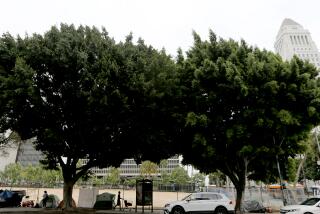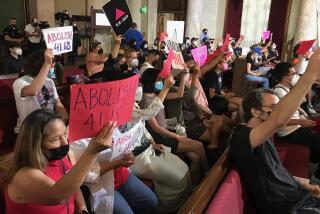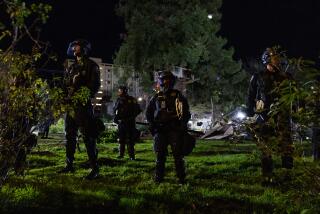Where to go from Zuccotti Park?
The ground had barely dried in New York’s freshly scrubbed Zuccotti Park when hundreds of angry Occupy Wall Street protesters crowded around its perimeter, staring down grim-faced riot police and vowing to reclaim the space.
For all the bravado, though, the city’s dismantling of their tent settlement was shattering to a movement that has been forced to confront a future far less idyllic than the one envisioned when Occupy Wall Street began.
With their tents, kitchen gear, generators and personal belongings seized by police, even die-hard Occupy Wall Street demonstrators acknowledged that the surprise post-midnight raid was a logistical setback that could force the movement to find a new home.
PHOTOS: Police clear out Zuccotti Park
Mayor Michael R. Bloomberg’s move against the campers came on the heels of a protest Monday by local business leaders outside City Hall, who complained that he was neglecting their rights in his effort to accommodate protesters’ rights to assembly and free speech. It also followed crackdowns elsewhere, which local officials have said were necessary as camps became increasingly filthy and plagued by reported crimes.
On Tuesday evening, after hours of growing tensions at Zuccotti Park, a judge upheld the city’s ban on tents and generators in the park, leaving would-be campers exposed to the elements with none of the creature comforts that had made their two-month stay tolerable.
Lawyers representing protesters played down the decision. “This is just a hiccup in the road,” said one, Danny Alterman.
Within a few minutes of the police reopening the park about 5:30 p.m., drummers whose constant playing had become a major irritant to many neighbors had resumed their rhythmic pounding. One joyful protester circled the park with a sign reading “Grand Reopening.” As they entered, the demonstrators chanted, “All day, all week, occupy Wall Street.”
But New York City’s action appeared to have emboldened Los Angeles, where Police Chief Charlie Beck said officials were working out a timeline to evict Occupy protesters from their camp outside City Hall.
In Oakland, Portland, Ore., and other cities where police have targeted Occupy encampments, protesters have been scattered and forced to ponder how to sustain the momentum that began Sept. 17, when scores of people demanding a crackdown on corporate greed staked their claim to Zuccotti Park and sparked a nationwide movement.
“It’s frustrating. We want to maintain a presence at Westlake Park, definitely,” said Aliana Bazara, a spokeswoman for Occupy Seattle, whose once-boisterous camp in the heart of downtown was shut down. Protesters now are allowed to remain there only until the 10 p.m. curfew and must camp in a tent city in a less-visible part of town, which hampers their goal of increasing community outreach.
“We need to get the movement back on track after this setback,” said Mark Bray, an Occupy Wall Street press officer. As New York protesters and police awaited the judge’s ruling, which came more than 12 hours after the 1:30 a.m. eviction, Bray argued that whatever property may have been lost, the ideals behind Occupy Wall Street remained.
“You can’t evict an idea,” he said.
But Bray acknowledged that with the loss of their tents and other infrastructure, protesters would have to find other places to occupy in a city that recently had seemed to lose patience with the noise, the crowds clamoring for free food and the campers streaming into businesses to use restrooms.
Many protesters, despite appearing distraught and bewildered in the hours after the raid, said the New York crackdown would help them by galvanizing opposition to such crackdowns, and some neutral observers agreed.
“Nothing helps a movement more than having a common enemy. Also, when a movement is able to stay nonviolent, it gives the movement the moral high ground,” said Heather Gautney, a sociology professor at Fordham University.
But Gautney also said Occupy Wall Street and its related protests had to face one fact: “The honeymoon is over.”
Gautney, who has studied other social movements as well as Occupy Wall Street, said its problems stemmed from reality clashing with the inclusive, leaderless, peaceful ideal of the first encampment at Zuccotti Park.
“In real life, there’s poverty and homeless people, and there’s crime,” Gautney said, citing issues that in recent weeks have arisen in Occupy camps, where rapes and theft have been reported.
Michael Heaney, a political science professor at the University of Michigan, said the nationwide crackdowns left Occupy Wall Street only one option: “Institutionalize or die.”
He said the movement’s tactic of occupying spaces in cities is unsustainable, so it must focus on legal tactics such as lobbying, involvement in elections, legal marches and testifying before Congress. “Making this shift will be tricky, if not impossible, because most of the core members have disavowed these tactics for ideological reasons,” Heaney said.
Indeed, in Oakland — the scene of the most violent clashes involving police and protesters — Iris Arcenciel, 26, said civil disobedience doesn’t mesh with taking direction from city leaders about how and where to protest.
“The important thing to remember is civil disobedience,” she said as Occupy Oakland supporters gathered to plan their next steps after their camp outside City Hall was cleared before dawn Monday. “That camp in front of City Hall makes a much larger statement than appeasing City Hall.”
Oakland’s exhausted mayor, Jean Quan, acknowledged the challenges ahead as both sides try to gain the upper hand. “If you look across the country, we even know that we may have to go and move the encampments again,” she said. “This is an international and national movement. This is their tactic.”
Bray said that protesters in New York had been holding secret meetings to discuss where they might move their occupation, given the new rules in Zuccotti Park. As the plaza reopened, police checked to make sure people weren’t carrying tents, but by 7 p.m. it was once again packed with people milling about and discussing where to spend the night.
“The place was taken from us, but the spirit was still there,” said Gayle Price, 46, who said the movement was about more than Zuccotti Park. “Something about not being attached to a place — this will shake the movement up and be positive and bring in new people. We just have to figure out how to keep warm.”
PHOTOS: Police clear out Zuccotti Park
Times staff writers Kim Murphy in Seattle, Lee Romney in Oakland and Kate Linthicum in Los Angeles; Alexa Vaughn in the Washington bureau; and Dawn Rhodes of the Chicago Tribune contributed to this report.
More to Read
Start your day right
Sign up for Essential California for news, features and recommendations from the L.A. Times and beyond in your inbox six days a week.
You may occasionally receive promotional content from the Los Angeles Times.







